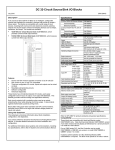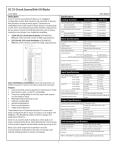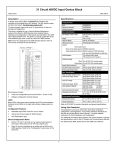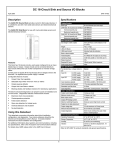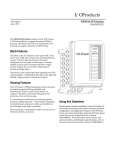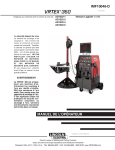Download Genius 32-Ckt DC Source/Sink Blocks datasheet, GFK
Transcript
This Datasheet for the IC660BBD024 Block 12/24Vdc Source I/O 32 Circuits http://www.cimtecautomation.com/parts/p-14432-ic660bbd024.aspx Provides the wiring diagrams and installation guidelines for this GE Series 90-30 module. For further information, please contact Cimtec Technical Support at 1-866-599-6507 [email protected] DC 32-Circuit Source/Sink I/O Blocks June 2002 GFK-0044F Description ____________________________________ Specifications __________________________________ Catalog Numbers 32 Circuit 12/24 VDC Source I/O Block Terminal Assembly Electronics Assembly 32 Circuit 5/12/24 VDC TTL Sink I/O Block Terminal Assembly Electronics Assembly Block Specifications Size (height x width x depth) A DC 32-Circuit Source/Sink I/O Block is an intelligent, configurable module that interfaces the controller to devices that provide or accept a binary signal. The blocks are compatible with a wide range of input devices, including both 2-wire and 3-wire electronic proximity switches. Outputs may be low-power control and indicating devices such as relays, contactors, and lamps. Two models are available: 12/24 VDC 32- Circuit Source block (IC66*BBD024), which provides current to field output devices. 5/12/24 VDC 32-Circuit Sink block (IC66*BBD025), which receives current from field output devices. Weight LEDs (I/O Block) LEDs (each circuit) Block to block Isolation Heat Dissipation 5/12/24 VDC Sink In/Out Operating voltage (one source) Ripple (maximum) Required DC power Power supply dropout time Input Specifications Input voltage relative to DCInput ON 5 VDC supply 12 VDC supply 24 VDC supply Input OFF 5 VDC supply 12 VDC supply 24 VDC supply Input impedance (typical) Input processing time (typical) Selectable input filter times Features Source and Sink versions each operate at nominal 12 to 24 volts DC Sink version is also +5 volt TTL-compatible Thirty-two configurable I/O circuits, inputs and outputs can be mixed on block Resettable self-protecting circuits Software configurable Advanced diagnostics IC66*BBD024 IC66*TBD024 IC66*EBD024 IC66*BBD025 IC66*TBD025 IC66*EBD025 8.83" (22.43 cm) x 3.58" (9.1 cm) x 4.7" (11.94 cm) 4 lbs. (1.8 kg) Unit OK, I/O Enabled Individual logic side indicators 850V 11W minimum with 8 inputs 18W maximum with 32 outputs at .5 Amp 10 to 30 VDC (12/24 V supply) 4.9 to 5.3 VDC (5 V supply) (sink only) absolute instantaneous limit 10% (12/24 volts) , 1% (5 volts) 150 mA typical/300 mA maximum 4 ms at 12 volts, 20 ms at 24 volts Source Blocks Sink Blocks not applicable 0-0.8 VDC 8-12 VDC 0-4 VDC 18-24 VDC 0-6 VDC not applicable 2-5 VDC 0-6 VDC 6-12 VDC 0-12 VDC 12-24 VDC 3.3K Ohms 1.4 ms (plus selectable filter delay) 1, 2, 3, 4, 5, 10, 20, 30, 40, 50, 60, 70, 80, 90, or 100ms Output Specifications Maximum output current (steady state) 0.5 Amps per circuit Maximum inrush current 4 Amps up to 10ms (once every .5 sec. maximum) Block output current (total) 16 Amps Output OFF leakage current 10µA, maximum Output turn-on delay 0.5 ms, maximum Output voltage drop 2.0 volts maximum at 4 Amps inrush Output Diagnostics Switch Fault Environmental Specifications Operating Temperature -0° to +60°C (32° to +140°F) Storage Temperature -40 °C (-40° to +212°F) Humidity 5% to 95% (non-condensing) Vibration 5-10 Hz 0.2” (5.08mm) displacement, 10-200 Hz at 1G These blocks have 32 identical discrete I/O circuits, each easily configured to be an input, an output, or an output with feedback. This flexibility provides maximum design and application efficiency. Each circuit contains built-in protection when used as an output, protecting the driver while allowing short-time surges. It also protects against shorted loads caused by wiring errors. Block LEDs verify proper block operation and CPU communications. Individual circuit LEDs on the logic side indicate voltage present on inputs and outputs.: Using this Datasheet ______________________________ Refer to GFK-0867 for product standards and general specifications. This datasheet summarizes information about block installation, configuration, and diagnostics. Compatibility __________________________________ These blocks are compatible with Hand-held Monitor model IC66*HHM501 only. Note that Hand-held Monitor IC66*HHM501 version A (an older version) will only display all references for a 32-circuit block if it is made the “Active Block”. Your primary reference should be the Discrete and Analog Blocks User’s Manual. It includes detailed instructions for block installation and configuration. For an IC600 series PLC, the Bus Controller may be model IC66*CBB902 or CBB 903, any version; or model IC66*CBB900 or CBB901 version 1.3 or later. For additional information about systems and communications, including bus specifications, refer to the I/O System and Communications Manual. If used to control operation of a Bus Switching Module, BSM IC66*BSM021 is required. The block must operate at 18 volts or above. 1 DC 32-Circuit Source/Sink I/O Blocks June 2002 GFK-0044F Installation Instructions __________________________ Grounding Carefully inspect all shipping containers for damage. If any equipment is damaged, notify the delivery service immediately. Save the damaged shipping container for inspection by the delivery service. After unpacking the equipment, record all serial numbers. Save the shipping containers and packing material in case it is necessary to transport or ship any part of the system. The block’s mounting screws must not be used as the only means of grounding the block. Connect the green ground screw on the block to a reliable ground system using a short wire lead, minimum size AWG #12 (avg 3.3mm2 in cross-section). Grounding Screw Block Mounting Genius I/O blocks are considered "open equipment" and therefore must be installed within a protective enclosure. They should be located in an area that is clean and free of airborne contaminants. There should be adequate cooling airflow. Alternate Ground Connection Point The block can be mounted right side up, or upside down. Leave at least 2 inches of space between blocks. Mount the block by drilling two screw or bolt holes for 8-32 hardware. Position the block so that the notches in the upper and lower flanges line up with the mounting holes. Mount the block using 8-32 screws. Use star washers to provide ground integrity. WARNING If mounting screws do not make good ground connection and the ground screw is not connected to a reliable ground, the block is not grounded. Electrical shock hazard exists. Death or personal injury may result. Removing an Electronics Assembly The block’s Electronics Assembly can be replaced with a compatible model without removing field wiring or reconfiguring the block. Serial Bus Wiring ______________________________ Do not overtorque the terminal screws. Recommended torque for all terminals is 6 in/lb (.678 N/M). Electronics Assembly Terminals 1 to 4 are for the serial bus. They accept one AWG #12 wire (avg. 3.3mm2 in cross-section) or two AWG #14 wires (each avg 2.1mm2). The minimum recommended wire size is AWG #22 (avg .36mm2). Retaining Screws (Qty. 2) Terminals 1 to 4 can also accommodate spade or ring lugs up to 0.27 inch (6.85 mm) in width with a minimum opening for a #6 screw, and up to 0.20 inch (5.1 mm) depth from the screw center to the back barrier. Be sure unshielded wire ends are not longer than 2 inches (5cm). Terminal Assembly Connector Pins Using one of the cable types recommended in the System and Communications User’s Manual, connect the serial bus to terminals 1- 4. (If a Bus Switching Module will be connected directly to the block, see below instead). 1. Unscrew the retaining screws at the top and bottom of the block. 2. Using a Block Puller (IC660BLM507), engage the tabs in the first vent slots. Move the tool to the center of the block and squeeze the handle. 1 SERIAL 1 3. Pull the Electronics Assembly upward. 2 SERIAL 2 3 SHIELD IN 4 SHIELD OUT WARNING If power is applied to the field terminals, power is also exposed on the connector pins at the base of the Terminal Assembly, and electrical shock hazard exists. Do not touch the connector pins! Death or injury may result. If the block is at either end of the bus, connect a terminating resistor of the appropriate type (see the System and Communications User’s Manual for details) across its Serial 1 and Serial 2 terminals. Start of Bus Inserting an Electronics Assembly 1. Terminating Resistor Align the Electronics Assembly in the guides and push down firmly. Serial 1 Serial 2 Shield In Shield Out CAUTION Do not exert excessive force; it may damage the block. If unusual resistance is met, remove the Electronics Assembly. If power is applied to the block, DO NOT TOUCH THE CONNECTOR PINS! Inspect the Terminal Assembly, connector receptacle, and connector edge board (on the Electronics Assembly). Be sure the keying matches. Remove any obstacles and reinsert the Electronics Assembly. Pay close attention to the alignment of the guide pins. 2. End of Bus Terminating Resistor Serial 1 Serial 2 Shield In Shield Out Wiring for a Bus Switching Module If the block will be a BSM Controller, attach the Bus Switching Module to the block’s serial bus terminals. Attach the serial bus cables to the BSM as described in the Bus Switching Module datasheet. Wire the BSM like a load to circuit 1. Connect either BSM pigtail wire to terminal 6. For a DC Sink block, connect the other BSM wire to DC+. For a DC Source block, connect the other BSM wire to DC-. Secure the Electronics Assembly with the screws on the top and bottom of the Terminal Assembly. 2 DC 32-Circuit Source/Sink I/O Blocks June 2002 GFK-0044F Field Wiring ____________________________________ Connections for a DC Sink Block Terminals 5 to 46 are for field devices. Each terminal accepts one AWG #14 wire (avg 2.1mm2 cross section), two AWG #14 (2.1mm2 cross section) solid wires, or two AWG #16 (each avg 1.3mm2 in cross section) stranded wires. For a Sink block, connect outputs to the positive side of the power supply and inputs to the negative side. Connect a DC source to the DC+ terminals (6-9) and the return to the DC- terminals (42-46). Any circuit can be an input or output. Connect one terminal of a field device to DC power and the other to the block (terminals 10-41). All I/O devices must return to the same power circuit. 5 6 7 N DEVICE 1 H Depending on layout and current loads, positive and negative connections can be bussed and made by single wires to the block or power source. 9 8 10 +5V DC+ DC+ DC+ DC+ 11 12 For TTL-Compatible Applications Only 13 5 14 6 15 7 16 17 9 18 Connections for a DC Source Block 8 19 20 21 For a Source block, connect outputs to the negative side of the power supply and inputs to the positive side. 22 SINK 23 OUTPUT SIGNAL 24 25 (10-41) DC+ 26 6 7 9 N DEVICE 1 H 27 DC+ DC+ DC+ DC+ DC+ 5 8 10 +5V DC+ DC+ DC+ DC+ TYPICAL OUTPUT DEVICE WIRING 28 29 30 31 32 INPUT SIGNAL 33 34 11 (10-41) 35 12 DC+ 36 13 37 14 TYPICAL INPUT DEVICE WIRING 38 15 39 16 N SOURCE 17 H OUTPUT SIGNAL 18 19 (10-41) 20 42 44 45 46 TYPICAL OUTPUT DEVICE WIRING 23 40 41 43 DC- 21 22 DEVICE 32 DCDCDCDCDC- 24 25 For correct 5 volt operation, power to the block, measured at the power supply input terminals, must be within the range 4.9VDC to 5.3VDC. 26 27 INPUT SIGNAL 28 (10-41) 29 DC+ 30 31 32 CAUTION TYPICAL INPUT DEVICE WIRING 33 34 Do not apply more than 5.25 volts to the +5V terminal. Damage to the block may result. 35 36 37 38 39 N H DEVICE 32 For 5 volt Sink applications only, jumper the +5V terminal to any DC+ terminal. CAUTION 40 41 DCDCDCDCDC- 42 43 44 45 46 For 12 or 24 volt sink applications do not jumper the +5V terminal to DC+. It will damage the block. Leave the +5V terminal open. DC Sink Block, Power Disconnects DC Source Block, Power Disconnects Since block power is the same as circuit power, it is important to wire block power disconnects so that block power and input power will be removed at the same time. Locate the power disconnect as shown below. It is important to wire block power disconnects so that block power and input power will be removed at the same time. Locate the power disconnect as shown below. YES NO DC SINK DC SOURCE BLOCK BLOCK DC+ DC+ LOAD LOAD DC- DC- CAUTION YES If circuit power is not removed at the same time as block power, the block may power up when multiple inputs are activated, even though one leg of power has been removed from the block. NO CAUTION If circuit power is not removed at the same time as block power, the block may power up when multiple inputs are activated, even though one leg of power has been removed from the block. If you want to disable the block without removing power from input devices, use a Block Puller to unplug the Electronics Assembly. Do not disconnect H or N to remove power. If you want to disable the block without removing power from input devices, use a Block Puller to unplug the Electronics Assembly. Do not disconnect H or N to remove power. 3 DC 32-Circuit Source/Sink I/O Blocks June 2002 GFK-0044F Block Operation ________________________________ Diagnostics __________________________________ These blocks provide 32 identical circuits, each configurable as an input or output. For both types of blocks, output circuits can be directly connected to input circuits without the use of other components or inversion of logic states. The block monitors outputs for overload conditions, and checks the actual state of the switch against the commanded state. In case of overload or wrong switch state, the block reports: FAILED SWITCH. Short Circuit/Overcurrent Protection: diagnostics protect individual output circuits against excess current. For Source blocks, the load usually gets short-circuited to the DC- side of the supply. For Sink blocks, the load usually gets short-circuited to the DC+ side. Source Block A DC source block has all output devices connected to the negative (-) side of the power supply. Inputs control the positive (+) side. For outputs, an ON condition is logic 1 and an OFF condition is a logic 0. DC+ Configured as an Input DC+ Input Device Smart Switch I/O * Configured as an Output If the output is commanded to go on and current exceeds 5 Amps for 1 ms, the circuit is automatically turned off and the FAILED SWITCH message issued. The circuit must be reset by cycling power to the block, or by sending a CLEAR FAULTS command from the Hand-held Monitor or the Bus Controller. Output Device Control Logic Surge Currents: Both Source and Sink blocks handle steady-state loads of 0.5 Amps during normal operation. Surge current protection determines conditions for safely switching loads between 0.5 Amps and 4 Amps. The following chart shows allowable surge transients. To/From Other Circuits 3.3K CURRENT (AMPS) 5.0 Field Connections DC- Terminal Assembly Electronics Assembly 4.0 DC- 3.0 2.0 * 39V Zener Diode 1.0 0.5 Sink Block 10 A DC sink block has all output devices externally connected to the positive (+) side of the power supply. Inputs control the negative (-) side. For outputs, an ON condition is logic 0 and an OFF condition is a logic 1. DC+ Configured as an Output Output Device DC+ 3.3K * Smart Switch I/O Configured as an Input Input Device Configuration ___________________________________ First, the block must be configured with a Hand-held Monitor to: Enter its Device Number (serial bus address). Enter its Reference Number (required only for IC600 and IC550 series PLCs only). Control Logic In addition, unless all circuits on the block will be inputs, the Block I/O Type must be set to either Outputs or Combination on the Program Block ID screen. DC- DCField Connections Terminal Assembly Note: If a block is configured offline, it must be properly grounded and have a 75 Ohm resistor installed across its Serial 1 and Serial 2 terminals. Electronics Assembly * 39V Zener Diode The rest of the features can be configured either using a Hand-held Monitor, or by sending a Write Configuration datagram to the block from the host. LEDs _______________________________________ The block's Unit OK and I/O Enabled LEDs show its operating status: Unit OK I/O Enabled ON Block functioning, CPU communicating ON OFF Block functioning, No CPU communications for 3 bus scans ON Blinking Block functioning, Circuit forced Blinking ON Circuit fault, CPU communicating Blinking OFF Baud Rate Block I/O Type Pulse Test Input Filter Time Circuit I/O Type Report Faults Hold Last State Output Default State BSM Present BSM Controller Output Timeout Redundancy Mode Duplex Def. State Config. Protect Circuit fault, No CPU communications for 3 bus scans Alternate Blinking Circuit fault, Circuit forced Synchronous Blinking No CPU communications - block number conflict OFF No block power, or block faulty OFF Feature Meaning ON 30 CAUTION Failure to operate a circuit within these limits may result in thermal overload and damage to the block. To/From Other Circuits .1µF 20 TIME (mS) Each circuit has its own LED. If the circuit is configured as an input, the LED indicates the presence of threshold voltage at the input terminal. If the circuit is configured as an output, the LED indicates the actual state of the load. 4 Circuit or Block B B B B C C C C B B B B B B Factory Setting 153.6 std input enabled 20ms input yes no off no no 2.5 sec. none off disabled Selections 153.6 std, 153.6 ext, 76.8, 38.4 input, output, combination enabled, disabled 1-100ms input, output yes, no yes, no on, off yes, no yes, no 2.5, 10 seconds none, standby, duplex, GMR on, off enabled, disabled





